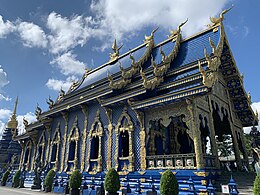Wat Rong Suea Ten

Wat Rong Suea Ten (Thai: วัดร่องเสือเต้น), also known as the Blue Temple, is a temple in Chiang Rai, Thailand, known for its striking modern artistic design.
The temple's construction was initiated by the local community in 1996 to replace an old abandoned temple which previously stood on the site, though construction did not start until 2005. Its final design was realized by local artist Phuttha Kabkaew (พุทธา กาบแก้ว) or Sala Nok (สล่านก, sala being a northern Thai title for an artisan), who learned from Chalermchai Kositpipat while working on his famous Wat Rong Khun, just outside the city. Wat Rong Suea Ten's main building was completed in 2016, and follows in the unconventional "neo-traditional" style of Buddhist art pioneered by Chalermchai, employing lavishly ornamented sculptures and psychedelic visual imagery.[1][2][3]
Architectural Features
[edit]Wat Rong Suea Ten is renowned for its striking and unique architectural design, which blends traditional Thai elements with contemporary artistic flair.
Exterior Design
[edit]The temple's exterior is characterized by its vibrant blue color, symbolizing the Dharma, the teachings of the Buddha. The use of blue is a departure from the more common gold found in traditional Thai temples, creating a visually stunning and serene atmosphere. The intricate details of the temple's facade include elaborate carvings and sculptures of mythical creatures, such as Naga serpents, which guard the entrance. These sculptures are adorned with gold accents, providing a striking contrast to the blue background.
Interior Design
[edit]Inside the main hall (ubosot), the walls and ceiling are adorned with elaborate murals depicting scenes from Buddhist mythology and the life of the Buddha. The murals are painted in vivid colors, predominantly blue, and are complemented by intricate gold leaf details. The centerpiece of the interior is a large, white Buddha statue, which exudes a sense of peace and tranquility. The statue is surrounded by smaller Buddha images and decorative elements that enhance the spiritual ambiance of the space.
Symbolism and Artistic Elements
[edit]The architectural design of Wat Rong Suea Ten is rich in symbolism. The blue color represents the infinite nature of the Dharma, while the gold accents symbolize enlightenment. The Naga serpents at the entrance are believed to protect the temple and its visitors from evil spirits. The use of modern artistic techniques alongside traditional motifs reflects the temple's aim to bridge the past and the present, creating a space that is both spiritually significant and visually captivating.
Surrounding Structures
[edit]In addition to the main hall, the temple complex includes several other structures, such as a smaller shrine and various statues of Buddhist deities. These structures are designed in a similar style, with blue and gold motifs, and contribute to the overall harmony and aesthetic appeal of the temple grounds. The surrounding gardens and water features further enhance the tranquil environment, making Wat Rong Suea Ten a popular destination for both worshippers and tourists.
Cultural and Religious Significance
[edit]Wat Rong Suea Ten holds profound cultural and religious significance within the local community and for visitors from around the world. This modern temple, completed in 2016, has quickly become a symbol of contemporary Thai Buddhist art and spirituality.
Local Community and Buddhism
[edit]For the local community, Wat Rong Suea Ten serves as a vital center for religious activities and community gatherings. The temple is a place where locals come to practice their faith, participate in Buddhist ceremonies, and seek spiritual solace. The presence of the temple reinforces the cultural heritage of the region, providing a space where traditional practices and modern interpretations of Buddhism coexist harmoniously.
Symbolism and Spirituality
[edit]The temple’s design and color scheme are imbued with deep symbolic meaning. The predominant blue color represents the Dharma, the teachings of the Buddha, which are considered infinite and boundless. This choice of color is intended to evoke a sense of calm and introspection among visitors, encouraging them to reflect on the teachings of Buddhism. The gold accents throughout the temple symbolize enlightenment and the ultimate goal of Buddhist practice.
The large white Buddha statue inside the main hall is a focal point for worshippers. This statue, surrounded by intricate murals and smaller Buddha images, serves as a reminder of the Buddha’s teachings and the path to enlightenment. The serene expression of the statue is meant to inspire peace and tranquility in those who come to meditate and pray.
Cultural Integration
[edit]Wat Rong Suea Ten also plays a significant role in the cultural landscape of Chiang Rai. It is part of a trio of modern temples in the region, alongside Wat Rong Khun (the White Temple) and Baan Dam (the Black House), each contributing to the area’s reputation as a hub of contemporary Thai art and culture. These temples attract both domestic and international tourists, fostering a greater appreciation for Thai artistic traditions and religious practices.
Festivals and Ceremonies
[edit]The temple hosts various Buddhist festivals and ceremonies throughout the year, which are attended by both locals and visitors. These events provide an opportunity for people to engage with Buddhist rituals, offer prayers, and make merit. The temple’s vibrant atmosphere during these festivals highlights its role as a living, dynamic center of religious and cultural life.
Educational Role
[edit]In addition to its religious functions, Wat Rong Suea Ten serves an educational purpose. The temple’s unique design and artistic elements offer insights into contemporary interpretations of Buddhist art. Visitors can learn about the symbolism behind the architectural features and the ways in which traditional Buddhist themes are expressed through modern artistic techniques.
Gallery
[edit]References
[edit]- ^ Silberling, Amanda (24 April 2019). "Reimagining Abandoned Buddhist Temples as Unconventional Art Spaces". Hyperallergic. Retrieved 28 August 2023.
- ^ "วัดร่องเสือเต้น ศิลปะวัดสีน้ำเงินแห่งเดียวในเชียงราย". Chiangrai Focus (in Thai). 16 November 2021. Retrieved 28 August 2023.
- ^ "พุทธศิลป์เบ่งบาน! ศิษย์ "เฉลิมชัย" ผสมแนวคิด "อ.ถวัลย์" ผุดวัดสุดวิจิตร". Manager Online (in Thai). 17 December 2015. Retrieved 28 August 2023.





